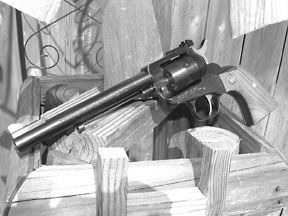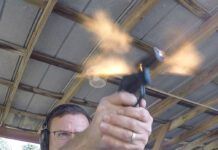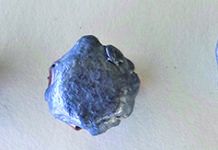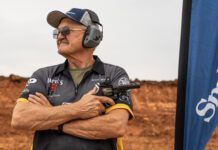
Last month we spent time shooting double-action revolvers chambered for the hot new .17 HMR cartridge, and we found the guns to be very accurate. But problems did arise. Each of the guns suffered from cylinder drag, due to what we believe was case setback. This is when rounds in the cylinder fail to stay seated after recoil, and their backward push interferes with rotation by rubbing against the breechface or blast shield. This problem occurred mainly during double-action fire, but also when we pulled the hammer back manually preparing for single-action shots. We wondered at the time if single-action revolvers themselves also suffered these problems. To find out, we rounded up two .17 HMR single actions, the Heritage Rough Rider and Sturm, Ruger’s New Model Single Six. Each gun closely resembled familiar Cowboy guns, but each had its own twist on this familiar design.
[PDFCAP(1)]Heritage Manufacturing is a small company located in Opa Locka, Florida. It produces rimfire revolvers exclusively. In our January 2001 issue, we tested a very similar Rough Rider with a 4.5-inch barrel chambered for .22 LR. The result was a “Best Buy” rating. This was our first experience with a Heritage product, which was unusual because it was a single-action revolver that came with a manual safety. The safety worked well, and we thought it was a great idea.
Combined with a low price, the Heritage design offers a lot for the first-time shooter. In this gun the shooter learns a little about history and a lot about safety. While the Rough Rider operates like an old west revolver, the shooter also develops semi-auto habits, such as “safety on.” With the safety in the up or “on” position, the hammer of the Rough Rider can be safely manipulated for loading. This means pulling the hammer back to half cock to load, then pulling it all the way back and releasing it for hammer-down position on a loaded chamber. Like any old-time single-action revolver, the trigger must be used to lower the hammer. Certainly it is always recommended to control the hammer when lowering it manually, but in the case of the Rough Rider the hammer is blocked from striking the firing pin when the safety is on. The firing pin is carried in the frame, not on the face of the hammer. Should one’s finger slip off the hammer with the safety on, the result will not be an accidental discharge. The only downside to this would be getting into the habit of dropping the hammer via the trigger without manually easing the hammer down. We think that ultimately, the habit of controlling the hammer may be more important than remembering to activate the safety.
Overall appearance of the Heritage Rough Rider was very good. The dark-blue finish was evenly applied, and we have not been able to make a mark on it. The wood grip featured a bold grain pattern. The catch for the base pin tended to seat a bit wobbly, but it never fell free or failed to do its job. Everything fit. There were neither sharp edges nor machine marks throughout the gun, and nothing came loose. The .17 HMR model we handled came with modern sights. In the rear we found a Millett-style white-outline sight, fully adjustable for windage and elevation. Up front was a tall thin post that was threaded with a red light-gathering filament. But even with modern sights we didn’t expect match-grade accuracy at a budget price.
[PDFCAP(2)]The Rough Rider liked the CCI Speer TNT bullet the best, printing a 1.2-inch group on the way to an average of 1.4 inches. This was fractionally better than the Ruger’s performance with this same round. However, in terms of average group size for all rounds fired, the Rough Rider lagged about a half inch behind the New Model Single Six. Still, compared to the performance of the .22 LR Rough Rider we previously tested at 15 yards, this is a big improvement. The average group size of the .22 LR model was nearly 2.5 inches for five shots. The .17 HMR Rough Rider showed it could average below 2 inches with a variety of ammunition at 25 yards.
Not everyone on the staff thought the filament front sight was that helpful, but we felt its tall shape was the more effective aspect of its design. Our shooters were neutral on the design of the rear sight blade. We all felt that the trigger was a little steep and maybe even too short. We would have liked a “sweet spot” solidly in the middle of the trigger. As it was, our fingers tended to drift to the bottom of the trigger face where it seemed to meet with a mild ball-like protrusion. The consensus was we were applying too much pressure to one point. We theorize that just changing the contour of the trigger’s face would improve control and accuracy.
[PDFCAP(3)]Just as there are few visual clues to differentiate the Rough Rider .17 HMR from the Rough Rider .22 LR, the Ruger New Model Single Six (catalog number 617) is a most familiar face. The finish is Ruger’s blue-gray, the grip is a densely grained wood and the hammer has the substantial cut and polished look commonly found on all Ruger revolvers. There is no on-off mechanical safety, but opening the loading gate does prevent the hammer from being pulled back. With the gate open, the cylinder moves freely for poking free expended rounds or to “fill ‘er up.” Loading and unloading the Rough Rider were smooth and trouble free operations. Unlike our experience with the double-action revolvers we tested in our last issue, we did not encounter cylinder drag or any other interruption in rotation. We did notice, however, that both our single-action revolvers were down on velocity compared to the double-action models from Smith & Wesson and Taurus. The Heritage revolver was down hundreds of feet per second, in fact, but the Ruger lagged only about 40 fps when compared to the Taurus Tracker .17 HMR that carried a barrel of similar length to our single-action test guns. The Remington ammunition we fired was a newly available round that we could not find for our last .17 HMR test. Accuracy with this round was comparable to the performance of the Hornady and Speer ammunition when fired in the New Model Single Six, but the Ruger turned its best performance when shooting the Hornady V-Max. In fact, this was the only combination that yielded a sub 1-inch group, putting it on par with the DA revolvers previously tested.
But the sterling characteristic of the New Model Single Six was its handling. The Ruger revolvers are very popular with the Cowboy Action crowd, and we think we know why. Like the other Ruger revolvers that we have tested, the .17 HMR New Model Single Six can be cycled and reloaded very quickly. One reason: It is easy to reset the hammer and keep the barrel on an even plane. This means the shooter can keep a good sight picture between shots. One of our staffers who favors speed-shooting competition with a single action semi-auto found the Ruger to be an ideal low-impact training gun in an exercise of rapid presentation and fire. The 617 was also a good weight for field carry. Extra weight is not necessary to dampen recoil even when the velocity of .17 HMR is up from the .22 WMR as much as 400 fps in a revolver.
Gun Tests Recommends
Heritage Rough Rider .17 HMR, $229. Buy It. This is a very good plinker at a low price. The Rough Rider offers features that make it unique among revolvers, single and double action alike.
Ruger New Model Single Six M617 .17 HMR, $389. Our Pick. This gun is fast handling, accurate reliable, and economically priced. After the troubles we had with the DA revolvers, the 617 made us a convert to this new round. Ironically, the simplest of the four .17 HMR revolvers we tested was also the most versatile.
The facts in this case are simple. The single-action revolvers ran trouble free and were less expensive than the double-action models tested last month. However, the double-action guns were more accurate. So which is better?
Unfortunately, we have to assume that our guns were representative of all individual products (as we always do), and that the problems we encountered with the double-action Smith & Wesson and Taurus revolvers have not been fixed as of this writing. As popular as the .17 HMR cartridge promises to become, we doubt that Taurus or Smith & Wesson will sit on their hands and not fix what we believe were case setback problems. Is it possible we just had the rare lemon in both double actions?
Until the mystery of smooth double-action fire is solved, we’ll take the $389 Ruger New Model Single Six loaded with Hornady’s own V-Max bullet and shoot to our heart’s content.
























Hmr pistol